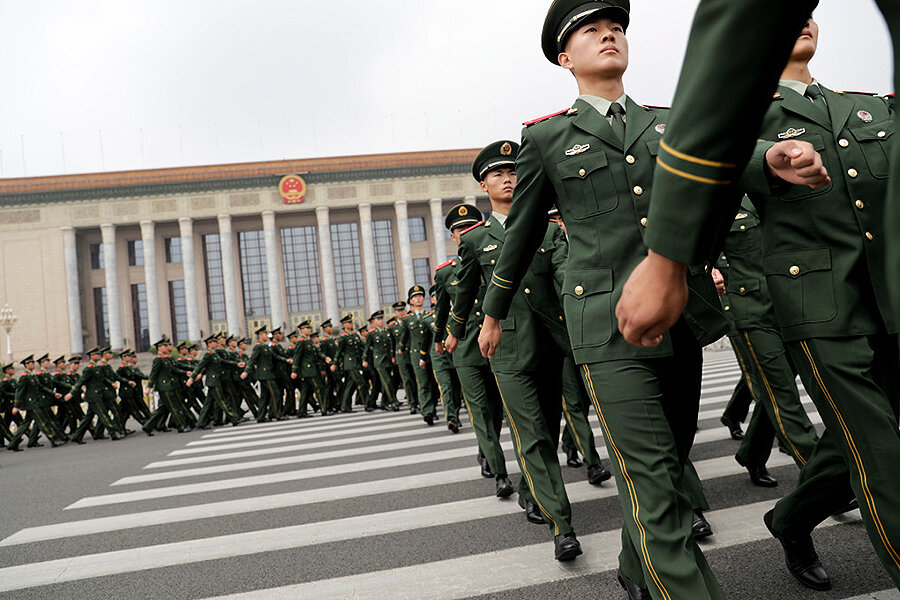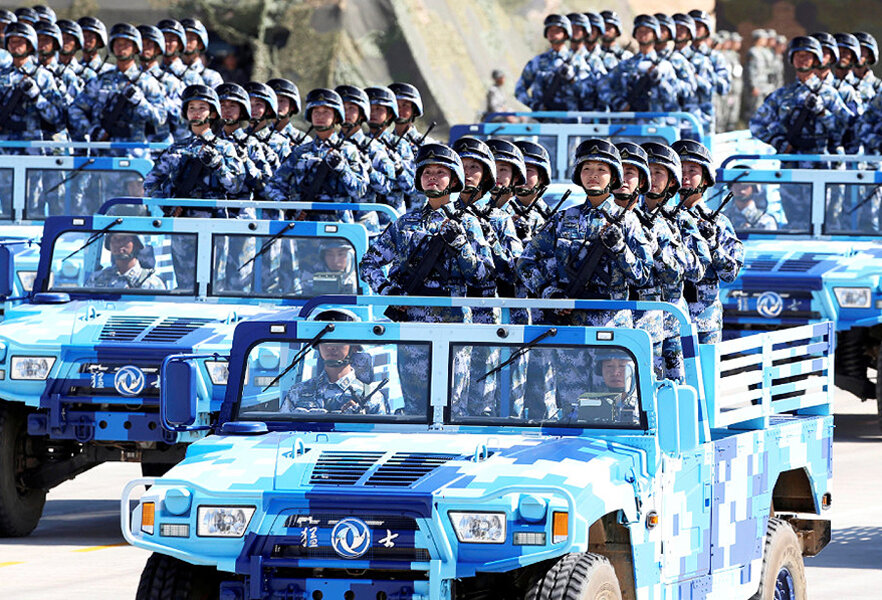As global reach grows, China builds military to match
Loading...
| Beijing
The military parade China held on Sunday to celebrate the 90th anniversary of the People’s Liberation Army was an impressive show of force. More than 12,000 troops marched at the remote Zhurihe training base in Inner Mongolia, about 250 miles north of Beijing, as President Xi Jinping looked on from an open-top jeep.
On display were 600 pieces of military hardware and more than 100 aircraft, nearly half of which were making their public debut, according to the Defense Ministry. They included new and improved intercontinental ballistic missiles, surface-to-air missiles, stealth fighters, and drones specifically designed to target radar systems.
Two days later, China formally opened its first overseas military base in the Horn of Africa nation of Djibouti.
The message sent by these two high-profile events was clear: as China seeks to expand its global clout and position itself as an international leader, it wants to have the military to match. Years of double-digit percentage increases in the defense budget have led China to become the world's second-largest military spender after the United States.
“The duty of the PLA [People’s Liberation Army] is to protect China’s national interests,” says Zhao Gancheng, a senior fellow at the Shanghai Institute for International Studies. “If China’s national interests expand to other parts of the world, its military ability will extend to those areas as well.”
A modern fighting force
The opening of the base in Djibouti is only the latest in a series of military milestones China has reached this year. In April, it launched its first domestically built aircraft carrier from the northeast port of Dalian. Then, in July, Chinese warships held drills with the Russian Navy in the Baltic Sea, more than 6,000 miles from their home ports – and in NATO’s backyard. The drills were China’s first war games in those waters.
China's military hasn't always been so well-equipped and far-flung. Formed in 1927, the PLA originally fought against China’s then-ruling Kuomintang, or Nationalists. After the PLA chased the Nationalists across the Taiwan Strait in 1949, it gained the reputation of being a bloated, poorly trained fighting force.
The modernization of China’s military has accelerated in recent years under Mr. Xi. As chairman of the Central Military Commission, Xi has implemented sweeping reforms aimed at transforming the PLA into a modern fighting force, including a reduction of 300,000 troops and a far-reaching crackdown on corruption. On Sunday, Xi said it was important for China to have a strong military “now more than any other time in history.”
“No one should expect us to swallow bitter fruit that is harmful to our sovereignty, security, or development interests,” he added on Tuesday, at a ceremony to mark the anniversary in Beijing’s Great Hall of the People. “The Chinese people love peace. We will never seek aggression or expansion, but we have the confidence to defeat all invasions.”
Guarding land and influence
With a standing military of 2.3 million members – the largest in the world – China has plenty of reasons to feel confident. But as the country’s global ambitions grow, so too does the risk of military conflict.
The South China Sea has long been a source of tension between China and its neighbors, as well as the United States. And now the country is bogged down in an armed standoff with India over a sliver of land in the Himalayas.
How China manages these disputes could have far-reaching implications for regional security, especially as it angles to supplant the US as the predominant military power in Asia. In his speech on Tuesday, Xi issued a tough line on national sovereignty, saying China will never permit the loss of “any piece” of its land to outsiders.
“China doesn’t want to have gunboat diplomacy used against it,” says Carlyle Thayer, an emeritus professor at the Australian Defence Force Academy at the University of New South Wales in Canberra. “It certainly has ambitions to deploy farther to better protect itself and its national interests.”
China’s ambitious “One Belt, One Road” initiative is the largest example of its growing influence beyond its own borders – and its need for an expanded global military presence. Through the initiative, Beijing has pledged $900 billion for the construction of infrastructure projects across Central Asia, the Middle East, and Africa.
But building roads, dams, and ports in many of these regions – some of the most unstable in the world – comes with serious challenges. Take Pakistan, for example, where China plans to spend $57 billion on joint infrastructure and industrial projects. Militants have killed more than 40 Pakistani workers on and around project sites since 2014. As China’s military capabilities improve, how the country uses them to protect its economic interests in places like Pakistan remains to be seen.
A long road ahead
Chinese officials say the new base in Djibouti – which they officially describe as a logistics facility – will enable China to better support anti-piracy operations off the coast of Somalia and peacekeeping operations across Africa. China has 2,400 troops serving as United Nations peacekeepers on the continent.
American military analysts say the base is a major strategic development for Beijing’s growing global ambitions and a possible threat to the longstanding dominance of the US military in Africa and the Middle East. Camp Lemonnier, America’s only permanent military installation in Africa, is just a few miles away.
Experts like Dr. Thayer, however, say that China has a long way to go before it catches up to the US on military grounds. The US spends more money on defense than the next seven countries combined – about $600 billion in 2016 alone. China has two aircraft carriers; the US has 10, with two more under construction.
Perhaps most importantly, the US has a large network of alliances that helps it maintain hundreds of bases with tens of thousands of troops in dozens of countries around the world.
“For China, there is no alliance system like the US has,” Thayer says. The Shanghai Cooperation Organization, a regional security group, is likely the closest thing.
“Where would China be able to put 38,000 troops in the world and be welcomed?” Thayer asks, a reference to the number of American troops stationed in South Korea. “I can’t see that happening for decades.”
Xie Yujuan contributed reporting.








